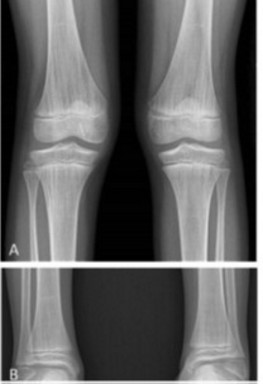(Robinow-Unger syndrome, generalized striated hyperostosis)
Prevalence: < 1/106. X-linked dominant transmission of a mutation of the WTX (Wilms' tumor) gene (AMER1 or CTNNB1) (Xq11.2).
Clinical presentation is highly variable. Girls present with macrocephaly, cleft palate, moderate learning difficulties, sclerosis of the long bones and skull bones, and longitudinal striae on the metaphyses of the long bones, pelvis and shoulder blades (image).

Cardiac malformations (IVC, aortic stenosis), developmental delay, cranial nerve palsies, anal malformations, cataracts and nervous system malformations are common. Vertebral anomalies (scoliosis, spondylolisthesis), extremity anomalies (clubfoot, very long and thin fingers with clinodactyly of the distal phalanges), hypertelorism, microretrognathia, frontal hump, broad nasal bridge, prominent occipital bone protrusion and mild intellectual deficit have also been documented.
In rare cases, association with Hirschsprung's disease, Pierre Robin sequence, craniostenosis, hydrocephalus and laryngotracheomalacia.
This pathology is usually lethal (death in utero or perinatally) in boys. In addition to hyperostosis, those who survive present cardiac, digestive and genitourinary malformations.
Somatic mutations of the AMER1 gene are found in 15-30% of Wilms' tumors, and a few cases of Wilms' tumor (sometimes bilateral) have been found in children suffering from this syndrome, justifying regular monitoring by abdominal ultrasound.
Striated osteopathy is frequently associated with focal dermal hypoplasia (see this term).
Anesthetic implications:
echocardiography, macrocephaly, risk of difficult intubation
References :
- Bach A, Mi J, Hunter M, Halliday BJ, García-Miñaúr S, Sperotto F et al.
Wilms tumor in patients with osteopathia striata with cranial sclerosis.
Eur J Human Gen 2021; 29: 396-401
- Sinibaldi L, Micalizzi A, Serra A4, Crocoli A, Camassei FD, Barbuti D et al.
Osteopathia striata with cranial sclerosis: a new case supporting the link with bilateral Wilms tumor.
Eur J Human Gen 2022 ; 30:262-4
Updated: October 2024